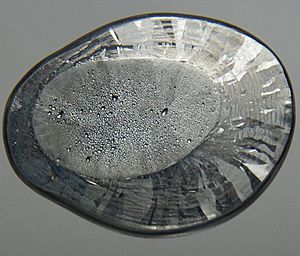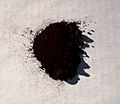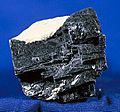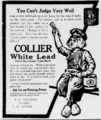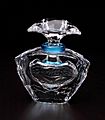Lead facts for kids
Lead (pronounce: "lehd") is a chemical element. Its chemical symbol is Pb, which comes from plumbum, the Latin word for lead. Its atomic number is 82, atomic mass is 207.2 and has a melting point of 327.8°C. It is a very poisonous and heavy metal.
Contents
Properties
Physical properties
Lead is a shiny, gray-blue poor metal. It gets tarnished easily to a dull gray color. It is soft and malleable. It is very shiny when it is melted. It is very heavy. It is very corrosion-resistant. It is made stronger by adding antimony or calcium. It can form an alloy with sodium. It is toxic to people and animals when swallowed.
Chemical properties
Lead burns in air with a grayish-white flame, making toxic fumes of lead(II) oxide. Only the surface is corroded by air. It dissolves in nitric acid to make lead(II) nitrate. It does not dissolve in sulfuric or hydrochloric acid. It reacts with sodium nitrate to make lead(II) oxide and sodium nitrite. It reacts with chlorine to make lead(II) chloride. Lead(II) oxide reacts with lead sulfide to make lead metal and sulfur dioxide.
Chemical compounds
Lead makes chemical compounds in two main oxidation states: +2 and +4. +2 compounds, also known as lead(II) compounds or plumbous compounds, are weak oxidizing agents. +4 compounds, also known as lead(IV) compounds or plumbic compounds, are strong oxidizing agents. Lead compounds are toxic just like the element. The lead halides do not dissolve in water. Lead(IV) oxide is the most common lead(IV) compound. It is a black solid. The lead oxides are all colored, while the other salts are white or colorless. Lead nitrate and lead(II) acetate are the soluble compounds of lead.
- +2 compounds
This state is more common than the +4 state. These are weak oxidizing agents. All but the oxides are colorless or white.
- Lead(II) acetate, colorless soluble
- Lead(II) arsenate, insoluble former pesticide
- Lead(II) bromide, insoluble
- Lead(II) carbonate, white, used as pigment
- Lead(II) chloride, insoluble
- Lead(II) nitrate, soluble, colorless
- Lead(II) oxide, red or yellow
- Lead(II) sulfate, white, found in lead acid batteries
- Lead(II) sulfide, black, common as mineral
- Mixed oxidation state compounds
Mixed oxidation state compounds contain lead in the +2 and +4 oxidation state.
- Lead(II,IV) oxide, red, oxidizing agent
- +4 compounds
These are less common. They are strong oxidizing agents.
- Lead(IV) acetate, oxidizing agent, colorless
- Lead(IV) oxide, dark brown, oxidizing agentCobalt compounds are chemical compounds containing cobalt ions.
Occurrence
Lead is found very rarely in the earth's crust as a metal. Normally, lead is in the mineral galena. Galena is lead sulfide. Galena is the main lead ore.
History
Lead was used for thousands of years because it is easy to get from the ground and easy to shape and work with. The Romans used lead very commonly. They used it for pipes, drinking vessels, and fasteners.
Preparation
Lead is made from galena. Galena is made pure by froth flotation to get all the impurities out. Then the lead sulfide is roasted in a furnace to make lead(II) oxide. The lead(II) oxide is heated with coke to make liquid lead metal.
Uses
As an element
Lead is used in the ballast of sailboats. It is also used in weight belts for scuba diving. It is also used to make shotgun pellets and bullets for small arms. Some printing presses use lead type because it can be easily shaped. It can be used outside because it does not corrode in water.
Most lead is used in lead acid batteries, though. The lead is oxidized, making electricity. Sheets of lead are used to block sound in some places. Lead is used in radiation shielding. Molten lead can be used as a coolant in nuclear reactors. It used to be mixed with tin to make the pipes in pipe organs. Different amounts of lead make different sounds. In addition, lead has found its usage in solder.
It is used in some solder. It is used in covering for wires that carry high voltage. Some tennis rackets have lead in them to make them heavier. It is used to balance wheels of cars, to make statues, and to make decorative looks in buildings.
As chemical compounds
Many lead compounds are used to make colored glazes in ceramics. Lead can be used in PVC pipes. Lead compounds are added to candles to make them burn better. Lead glass has lead(II) oxide in it. Lead compounds are still used as pigments in some places. Lead compounds were added to gasoline, but are now outlawed. Some lead compounds are semiconductors and are used in photodetectors.
Old uses
Lead was used in many red, yellow, and white pigments in paints. Lead was also used in pesticides. Lead used to be used in pipes carrying water, but now it is not because lead can leach into the water.
Safety
Although it can be safely touched, exposure to lead should be avoided – it is very toxic to humans and other animals when swallowed, and its use is restricted in many countries.
If someone is exposed to lead for a long time, it ruins their kidneys and gives them abdominal pains. Lead also ruins the nervous system. Lead paint was being eaten by children and they were getting lead poisoning.
The best way to understand lead and its properties is to read its MSDS.
Related pages
Images for kids
-
The Holsinger meteorite, the largest piece of the Canyon Diablo meteorite. Uranium–lead dating and lead–lead dating on this meteorite allowed refinement of the age of the Earth to 4.55 billion ± 70 million years.
-
Lead mining in the upper Mississippi River region in the United States in 1865
See also
 In Spanish: Plomo para niños
In Spanish: Plomo para niños


